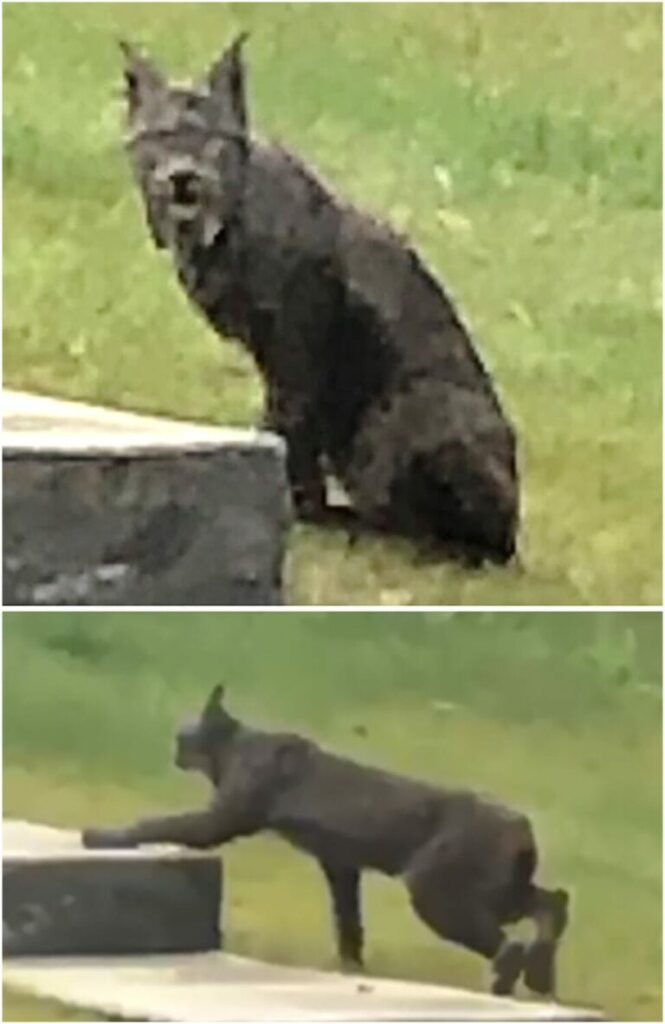The Magnificent Canada Lynx: A Story of Black Coats and Evolutionary Curiosity
The Canada Lynx, scientifically known as Lynx canadensis, is a remarkable feline species indigenous to the picturesque landscapes of North America. From the pristine wilderness of Canada to specific regions in the United States, this majestic creature has captured the imaginations of nature enthusiasts and researchers alike.
Typically adorned in a light brownish-gray fur coat, the Canada Lynx has long been recognized for its distinctive appearance. However, nature occasionally surprises us with unexpected variations, and reports of black-furred individuals have intrigued many.

For years, the enigmatic black-colored Lynx remained elusive, defying the lens of any camera. But fate had other plans, and a fortunate encounter would change everything in the lucky year of 2022.
Deep within the Canadian wilderness, a researcher from the esteemed University of Alberta embarked on a mission to unravel the mysteries of the Canada Lynx.
Armed with dedication and a keen eye, this courageous individual sought to capture the essence of this elusive feline. Thomas Jung, an employee of the Yukon government, would unknowingly play a pivotal role in this unfolding saga.
It was on a tranquil day amidst a rural residential neighborhood near the bustling metropolis of Whitehorse that fate intervened. Going about his daily routine, Thomas Jung found himself in the presence of greatness.
With his trusty phone in hand, he became a witness to an extraordinary sight. The lens of his camera phone captured the Canada Lynx in all its ebony glory.
Word of this groundbreaking footage quickly spread, leaving researchers and wildlife enthusiasts astounded. The revelation of melanism in the Canada Lynx, first documented in an article in the prestigious journal Mammalia, ushered in a new era of fascination.
The shaky yet mesmerizing video showcased the Lynx in its natural habitat, basking in the serenity at a distance of roughly 50 meters.
Nearby, unsuspecting humans and a vigilant canine unknowingly shared the presence of this ebony marvel. Eventually, the Lynx retreated, prompted by the barks of the curious dog.
Experts, although identifying the creature as a Canada Lynx, could not discern many distinguishing features from the footage’s trembling frames.

Nonetheless, Jung’s vivid recollection painted a picture worth a thousand words. “It had a black coat with whitish gray guard hairs all over and whitish gray hairs in the facial ruff, the rostrum, and the dorsal regions,” he recounted.
A common hue prevails among the various species of Lynx, with Canada Lynx often exhibiting a silvery gray coat during the winter months.
However, the summer sun has a transformative effect, adorning their coat with a reddish-brown tapestry. Thus, the Lynx depicted in the great video is a testament to this species’ extraordinary diversity.
Biologists and researchers have long marveled at the variations within the animal kingdom, recognizing that differences often serve as adaptations advantageous for evolution or, conversely, as maladaptive traits.
Melanism, a phenomenon observed in various creatures, has piqued the curiosity of scientists worldwide. While the advantages or disadvantages of melanism remain uncertain, Jung leans towards considering the Lynx’s feature maladaptive due to its potential lack of essential camouflage.
The dark-coated Lynx might stand out in the winter snowscape, making its hunting endeavors more conspicuous.
The rarity of such an encounter has left us in awe, and we struggle to comprehend the sheer magnificence of this creature.
As we invite you to share your thoughts and ideas below, let us revel in the wonders of the natural world and celebrate the remarkable Canada Lynx and its captivating journey into the annals.





